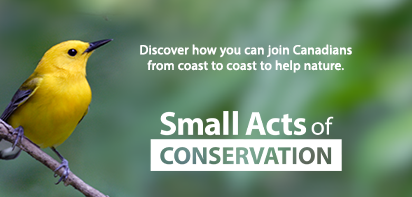Nature Conservancy of Canada grows conservation efforts in southwestern Newfoundland
Protecting and conserving biodiversity in the Grand Codroy Valley
The Nature Conservancy of Canada (NCC) announced today that it has protected 30 hectares of boreal forest centred around Grand Daddy’s Brook. The brook is a tributary that feeds into the province’s most productive wetland, the Grand Codroy Estuary. The conservation land is located near the community of Millville and approximately 50 kilometres north of Port aux Basques.
The rolling landscape at Grand Daddy’s Brook features a dense mixed forest abundant with mature yellow birch trees. The trees provide ideal habitat for a variety of at-risk birds, including olive-sided flycatcher (special concern), evening grosbeak (special concern) and red crossbill (threatened) all of which are listed under Canada’s Species at Risk Act. Surveys conducted in the broader Codroy Estuary area have also confirmed the presence of bobolink (special concern), short-eared owl (threatened), bank swallow (threatened), wrinkled shingle lichen (threatened) and monarch butterfly (endangered).
Since 1997, NCC has worked closely with private landowners to protect the area’s natural heritage and rich biodiversity. This announcement marks the 10th addition to NCC’s Grand Codroy Estuary Nature Reserve, bringing the total conservation area to 293 hectares. Codroy Valley Provincial Park is in the nearby vicinity.
This important land purchase was made possible thanks to the generosity of individuals, private donors and corporate partner Walmart Canada. It was also supported by funding from the Government of Canada, through the Natural Heritage Conservation Program, part of Canada’s Nature Fund.
NCC and its supporters and partners continue to explore ways to grow conservation efforts in this biodiversity-rich area and to protect additional natural habitats needed for species at risk to roam and thrive. The organization’s work is driven by science-based evidence and advanced by state-of-the-art conservation tools and the precise data needed to pinpoint the most ecologically critical areas for protection and conservation.
In the face of rapid biodiversity loss and climate change, nature is our ally. There is no solution to either without nature conservation. When nature thrives, we all thrive.
Quotes
“The Natural Heritage Conservation Program brings the Government of Canada one step closer toward its goal of conserving 30 percent of lands and waters in Canada by 2030. By working with partners such as the Nature Conservancy of Canada, we are helping to protect boreal forest in Grand Codroy Valley, in Newfoundland and Labrador, and across the country. Protecting land plays a vital role in helping to halt and reverse biodiversity loss and contributes to the protection of species at risk.” – The Honourable Steven Guilbeault, Minister of Environment and Climate Change
“Walmart Canada is in its third year of working with Nature Conservancy of Canada. Our projects have helped to enhance conservation efforts and support regeneration. This latest initiative in Newfoundland is an important opportunity to protect the area’s wildlife and their habitats.” - Rob Nicol, vice president, communications and corporate affairs, Walmart Canada
“The Grand Codroy Estuary has been a key priority for us since we began working in Newfoundland and Labrador. We continue to be amazed by the beauty and biodiversity of this area, and we are proud to continue our efforts to conserve this area, which is globally recognized for its importance to migratory bird species. This new project is another step toward ensuring the Codroy Valley will remain a haven for many species far into the future.” – Piers Evans, NCC Program Director in Newfoundland and Labrador
Facts
- The community of Millville was established in 1897 when a dam and waterwheel on Grand Daddy’s Brook powered the Gale Carding Mill, producing 10,000 pounds of wool annually.
- The Grand Codroy Estuary is a wetland of international importance under the Ramsar Convention on Wetlands and Canada’s Important Bird Areas program. The area has over 200 different bird species, more than half of all avian species in the province. The estuary is home to 15 species of risk, including six that are considered globally significant, as assessed by the Committee on the Status of Endangered Wildlife in Canada. This diversity of species and ecosystems is a testament to the ecological importance of the region.
Keep The Rock Rugged
This project was completed through NCC’s Keep The Rock Rugged fundraising campaign. Launched in October 2021, the campaign aims to expand upon the footprint of existing nature reserves at Salmonier River and Grand Codroy Estuary. NCC’s goals are to double the number of science internships, support more Conservation Volunteers events and conduct important research that advances conservation efforts. Learn more and contribute to helping keep Newfoundland and Labrador’s natural areas clean and healthy by visiting Keep The Rock Rugged
About
The Nature Conservancy of Canada (NCC) is the country’s unifying force for nature. NCC seeks solutions to the twin crises of rapid biodiversity loss and climate change through large-scale, permanent land conservation. As a trusted partner, NCC works with people, communities, businesses and government to protect and care for our country’s most important natural areas. Since 1962, NCC has brought people together to conserve and restore more than 15 million hectares. In the Atlantic provinces, NCC has protected 40,750 hectares.
The Government of Canada’s Natural Heritage Conservation Program (NHCP) is a unique partnership that supports the creation and recognition of protected and conserved areas through the acquisition of private land and private interest in land. To date, the Government of Canada has invested more than $470 million in the Program, which has been matched with more than $982 million in contributions raised by Nature Conservancy of Canada, Ducks Unlimited Canada and the country’s land trust community leading to the protection and conservation of nearly 800,000 hectares of ecologically sensitive lands.
Learn More
Follow us on on X (formerly Twitter): x.com/NCC_CNC | x.com/NCC_CNCMedia
Find us on Facebook
- 30 -




